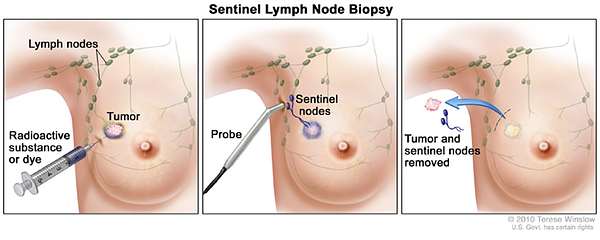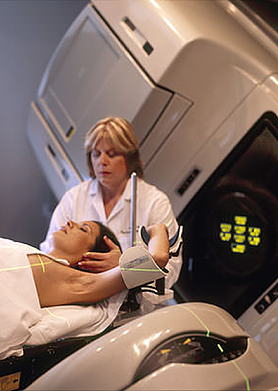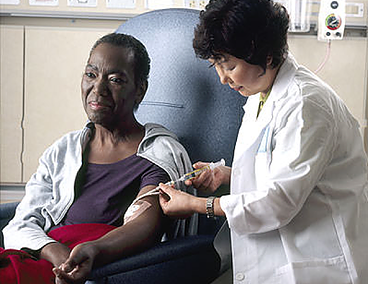Treatments

Now more than ever, health care providers are able to treat cancer in a number of different ways. Each individual’s treatment may depend on the stage of breast cancer they have, and the plan their doctor recommends.
In the modern era, breast cancer treatment includes local and regional approaches (surgery and radiation therapy) in addition to medical therapies designed to treat systemic disease. Multimodality treatment approaches were the first to show significant improvements in locoregional control and survival. As breast cancer was being recognized at earlier stages, the radical mastectomy was abandoned in favor of more conservative surgical approaches in combination with radiation therapy.
The result was dramatic reductions in the extent of surgery required for local control of breast cancer and decreases in treatment-related morbidity. Breast cancer is a heterogeneous disease, and current treatment is guided by properties of the individual patient’s tumor as well as the size and location of the tumor.
- Sentinel Lymph Node Biopsy (SLNB)
- Radiation
- Chemotherapy
- Breast-Conserving Surgery
- Mastectomy
- Reconstructive Surgery
A sentinel lymph node is the first lymph node which cancer cells go to from the primary tumor. There may be more than one sentinel lymph node.
The technique of SLND was developed to reduce the morbidity associated with axillary surgery, while still providing accurate staging information. Many patients now present with clinically node-negative disease, and SLND can identify patients with proven node-positive disease who may benefit from completion ALND. Patients with negative sentinel lymph nodes can avoid the morbidity of axillary dissection.
A sentinel lymph node biopsy (SLNB) is a procedure in which the sentinel lymph node is:
- Identified
- Removed
- Examined
This procedure determines if cancer cells have spread to the lymphatic system. If cancer cells are present in the lymph, then there is a possibility it can or has already spread to other organs of the body.
A sentinel lymph node biopsy aides the doctor in:
- Determining what stage the cancer has reached
- Developing a treatment plan for the patient
- Preventing the spread of breast cancer

Radiation is the use of high-energy rays which kill cancer cells.
For patients with invasive breast cancer treated with breast-conserving surgery, adjuvant irradiation of the breast has been conclusively demonstrated to reduce the probability of a breast recurrence and improve outcome.
There are several different types of radiation:
 External Beam Radiation
External Beam Radiation
- Most common type of radiation.
- Radiation comes from a machine outside of the body, and focuses on the area which has cancer.
- Painless
- Actual procedure time only takes a few minutes, set-up time usually takes longer.
- Possible side effects
Brachytherapy (Internal Radiation)
- Swelling or heaviness of breasts.
- Skin changes such as redness, blistering, and peeling of treated area.
- Fatigue.
- Radioactive seeds are placed into a device which is then placed in the breast tissue where the cancer was detected.
- Can be used with external beam radiation.
Chemotherapy treatments are cancer killing drugs that can be given by mouth, or injected into a vein.
Chemotherapy is generally administered with combinations of medications in an effort to take advantage of nonoverlapping toxic effects and maximize different mechanisms of action in targeting tumor cells.
The drugs travel through the bloodstream to reach cancer cells in the body. Chemotherapy is given in cycles, and the treatment can last several months. While on chemotherapy you may experience possible side effects including:
 · Hair loss
· Hair loss
· Fatigue
· Loss of appetite or increased appetite
· Nausea and vomiting
· Easy bruising
Breast-Conserving Surgery can also be called a partial or segmental mastectomy, or lumpectomy.
Excision of the primary tumor with preservation of the breast has been referred to by many terms, including lumpectomy, partial mastectomy, segmental mastectomy, segmentectomy, tylectomy, and wide local excision. Breast-conserving surgery removes the malignancy with a surrounding rim of grossly normal breast parenchyma.
Surgical staging of the axilla is performed through a separate incision in most patients undergoing breast conservation. SLND. has replaced anatomic axillary node dissection in patients with clinically negative axillary nodes. For patients who require axillary dissection, the extent of the dissection is identical to the axillary component of the modified radical mastectomy

A mastectomy is when the breast tissue is removed, and possibly some surrounding tissue.
Indications
Certain tumors still require mastectomy, including tumors that are large relative to breast size, tumors with extensive calcifications on mammography, tumors for which clear margins cannot be obtained on wide local excision, and tumors in patients with contraindications to breast irradiation. Patient preference for mastectomy or a desire to avoid radiation is also a valid indication for mastectomy.
Absolute
- Pregnancy
Relative
- Systemic scleroderma*
- Active systemic lupus erythematosus*
- Prior radiation to breast or chest wall
- Severe pulmonary disease
- Severe cardiac disease (if tumor is left-sided)
- Inability to lie supine
- Inability to abduct arm on affected side
- p53 mutation
There are different types of mastectomies:
Simple mastectomy (total mastectomy)
- Removal of entire breast, including nipple.
- Sometime both breasts are entirely removed (double mastectomy).
- Can be used as a preventative measure in women who are at high risk for breast cancer.
Skin-sparring mastectomy
- Most of the skin over the breast, not including the nipple or areola, are left intact.
- Often used when a woman chooses to have reconstruction surgery.
Modified radical mastectomy
- Removal of the entire breast, underarm lymph nodes, and chest wall muscles under the breast.
- Rarely done, but may be used for large tumors growing in the chest muscles under the breast.

Radical mastectomy
- Removal of the entire breast, underarm lymph nodes, and chest wall muscles under the breast.
- Rarely done, but may be used for large tumors growing in the chest muscles under the brea
Reconstructive Surgery is a procedure done to restore the appearance of the breast after a mastectomy or breast-conserving surgery.
For more information on breast recontruction, visit the section titled “Breast Reconstruction Awareness USA.”
- Rare type of breast cancer
- Approximately accounts for 1% of all breast cancers
- Cancer starts in the breast ducts, then spreads to the skin of the nipple, and areola
- Usually associated with ductal carcinoma in situ (DCIS) or invasive ductal carcinoma (IDC)
- Symptoms may consist of the nipple and areola being:
- Crusted
- Scaly
- Red
- Bleeding or oozing
- Burning
- Itching
